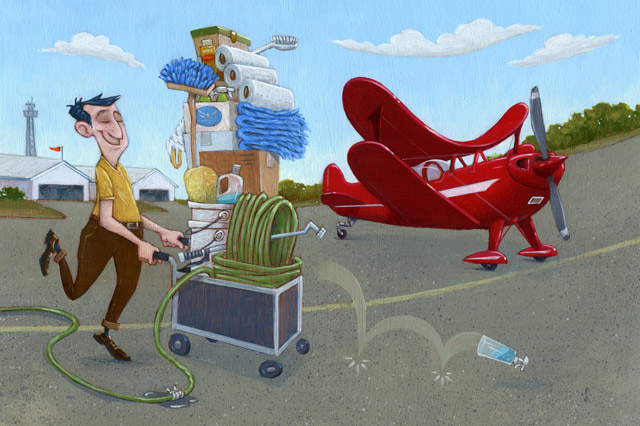
Give your aircraft a bath
The adage that “A clean airplane is a safe airplane” has some truth in it.
When you wash your airplane and touch every inch of its surface, you notice details that are otherwise easy to overlook. Loose or missing screws and fasteners, bends or cracks in the skin, chafing control surfaces, missing rubber on fairings—the list goes on and on.
Pilots who pay others to wash their airplanes miss out on this hands-on learning opportunity, and the chance to head off little problems before they become big ones. They also risk exposing their airplanes to the harm that can come from clogged static ports, broken antennae, and other byproducts of well-meaning but ill-informed or heavy-handed “helpers.”
Cleaning your airplane comes in two basic varieties: Full spinner-to-tail wash and wax jobs, and basic postflight touchups.
My former airplane partner, Don Hailey, a fireman, was a master at the full polish. My compulsion was the postflight touchup. The tiny Pitts S–1C we co-owned gleamed as a result of our mutual efforts.
Hailey eschewed fancy chemical cleaning products in favor of warm water, mild soap, and lots of rubbing. He’d never forcefully spray water on the airplane since that can do more harm than good. Pressurized water from a hose can peel paint—especially on fabric airplanes—and force its way into places water shouldn’t be. Better to apply it with a sponge or rag, and then dry with towels.
Once the airplane surface is free of dirt, spray-on wash wax can give it a protective coat and make it shine. Any number of inexpensive automotive products can do well in this area, such as Meguiar’s Ultimate Quick Detailer, or aviation-optimized Wash Wax by Aero Cosmetics. For shiny metal surfaces such as the spinners, Mothers Metal Polish works wonders. The real key is getting the remnants off when you’re finished, and the only shortcut I know there is rubbing it off with cornstarch and a dry rag.
For basic postflight touchups, a spray bottle of water is hard to beat. The sooner you spray and wipe the leading edges, the easier it will be to remove the bugs. I got in the habit of doing it as soon as I put the airplane in the hangar, and it’s as much a ritual as putting chocks under the tires or filling out a logbook. Now, it seems wrong to leave the hangar without giving the airplane a quick once-over.
Pledge is good for cleaning both the airframe and the windshield—but make sure you don’t use anything with ammonia, as it can damage windshields.
And while we’re on the subject of things not to use, several come to mind: Simple Green All-Purpose Cleaner is a terrific grease-cutting solvent, but it may promote corrosion if left too long on some metal surfaces. The company recommends a specialized product called Extreme Simple Green for aircraft.
Ubiquitous lubricant WD40 also should be avoided because it can leave a varnish when it dries that attracts dirt and moisture, which actually can cause corrosion. Better to use a specialized aviation product such as LPS, even though it costs more.
Let’s keep it clean out there!
Email [email protected]
AOPA Frugal Flier coverage sponsored by Aircraft Spruce



